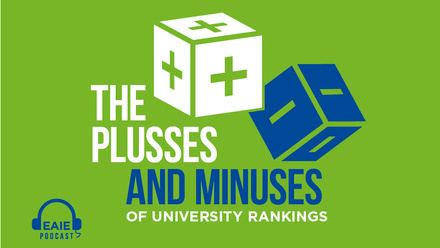Measuring our impact: mission impossible?

As public scepticism of globalisation continues to surge in many parts of the world, the trend within international higher education is one towards measurement and justification of the impact of internationalisation. But what is ‘impact’, and how do we measure it? EAIE Vice-President Michelle Stewart illuminates one path towards assessing the relevance of our work as international educators.
In a panel discussion at the 2017 British Council Going Global Conference, Dr Nico Jooste, Senior Director of International Education at South Africa’s Nelson Mandela Metropolitan University, cautioned that “growing public hostility towards globalisation and immigration will push the need to evidence the impact of internationalisation.”
This resonates with the growing calls to evidence the role of the university in helping to tackle societal challenges facing local and global communities. This trend has pushed the concept of the ‘third mission’ to the forefront of higher education policy discussions – often described in terms of ‘relevance’ and ‘impact’.
The concept of delivering benefits and making a difference is embedded in everything we do as higher education institutions.
There are well-established mechanisms for measuring the quality of research and teaching. The UK Research Excellence Framework (REF), as one example, includes an assessment of impact. While the UK REF provides the means for a formal assessment of the wider societal impacts of research, there are as yet no similar assessments covering the impact of teaching or other core activities. This ‘gap’ extends to the need to develop an assessment of internationalisation and its broader impacts.
Addressing this is important for two main reasons:
- the global, transnational nature of the challenges facing the world and the fact we are more likely to address them effectively through collaboration, and
- the need to evidence the growing importance of internationalisation activities against a background of ‘anti-everything’ sentiments.
However, the need to assess the impact of internationalisation should not be confused with the need to view impact itself as a separate category of activities to be assessed.
The pitfalls of describing internationalisation as a separate activity
The concept of delivering benefits and making a difference is – or should be – embedded in everything we do as higher education institutions. It is therefore a distraction to talk about impact as something separate from our other activities.
This is certainly the conclusion reached when we speak of research impact. Impact is part of the long-term research trajectory and must be thought of, understood and planned for, as appropriate, from the start of the research design. Research – and teaching – are the starting points for generating impact beyond the university walls, not separate activities that sit parallel to impact.
Internationalisation, if it is truly integrated, will be embedded in and encompass a diversity of activities, from knowledge exchange to industry collaborations, international development projects and consultancy, and transnational education. The tendency to refer to internationalisation achievement only in terms of student recruitment and exchange – perhaps because these are relatively easy to measure – overlooks other important areas which should be included, and measured, as part of a wider university strategy, or as a separate internationalisation strategy. Ensuring internationalisation is integrated in all activity strands will provide a framework through which our research, teaching and engagement will bring even greater reach and significance to the impacts we generate – the difference we make.
Measuring impact
The impact of internationalisation activities is complex and multi-faceted. Articulating the significant benefits achieved will require new measures that provide robust evidence of change.
How do we, as international educators, respond to the real challenge (and opportunity) of broadening the range and definition of internationalisation and agree on measures to assess its impact?
The first step will entail not only agreeing on how we measure the impact of the work we do, but also agreeing that the impact is the work.
The answers lie in the need to understand the difference we make and to whom, and to consider how best to measure/assess success in the immediate and longer term.
If a university is genuinely committed to an international vision and to ensuring that its work delivers wider societal impacts, then it is reasonable to expect that activities around teaching and research will extend beyond generating income from overseas student fees and measuring student exchange. We know that research and teaching are valuable activities, but we have been forced to articulate our understanding and the justification for that claim in a much more granular and evidence-based way than before.
Comprehensive internationalisation has the potential to make a real difference to students and staff and their institutions, communities and societies at home and abroad. The EAIE community believes that internationalisation activities are valuable, but how do we know (and how can we show) that we deliver benefits to individuals and communities here and abroad? The need to make a compelling case for internationalisation leaves us with a set of questions to ask ourselves:
- Can we articulate what the benefits are, to ourselves and to partner institutions?
- Can we identify what we as individuals, institutions and societies might know, understand or do as a result of these activities that we might not know, understand or do otherwise?
- Can we describe the ‘gap’ which our internationalisation activities address?
- Can we articulate what we believe changes as a result of these activities, or what would be substantively affected or not occur at all if we didn’t engage in internationalisation?
The need to go beyond the obvious and find ways to systematically measure the impact of internationalisation – not as a separate activity, but as a fundamental part of our day-to-day work – may require like-minded associations to work with our communities to agree a set of standards and measures to facilitate a sector-wide assessment. In any case, the first step will entail not only agreeing on how we measure the impact of the work we do as internationalisation professionals, but also agreeing that the impact is the work.
At the end of January, the UK Government confirmed that there would be no guarantee of funding for ERASMUS + in the event of ‘no deal’ on Brexit. This announcement served to ignite widespread support for student mobility, and social media channels are full of stories of the impact study abroad has had on so many people. If there were, a way to systematically measure the difference study abroad has made, then perhaps the value of internationalisation would be at the forefront of the political agenda.






